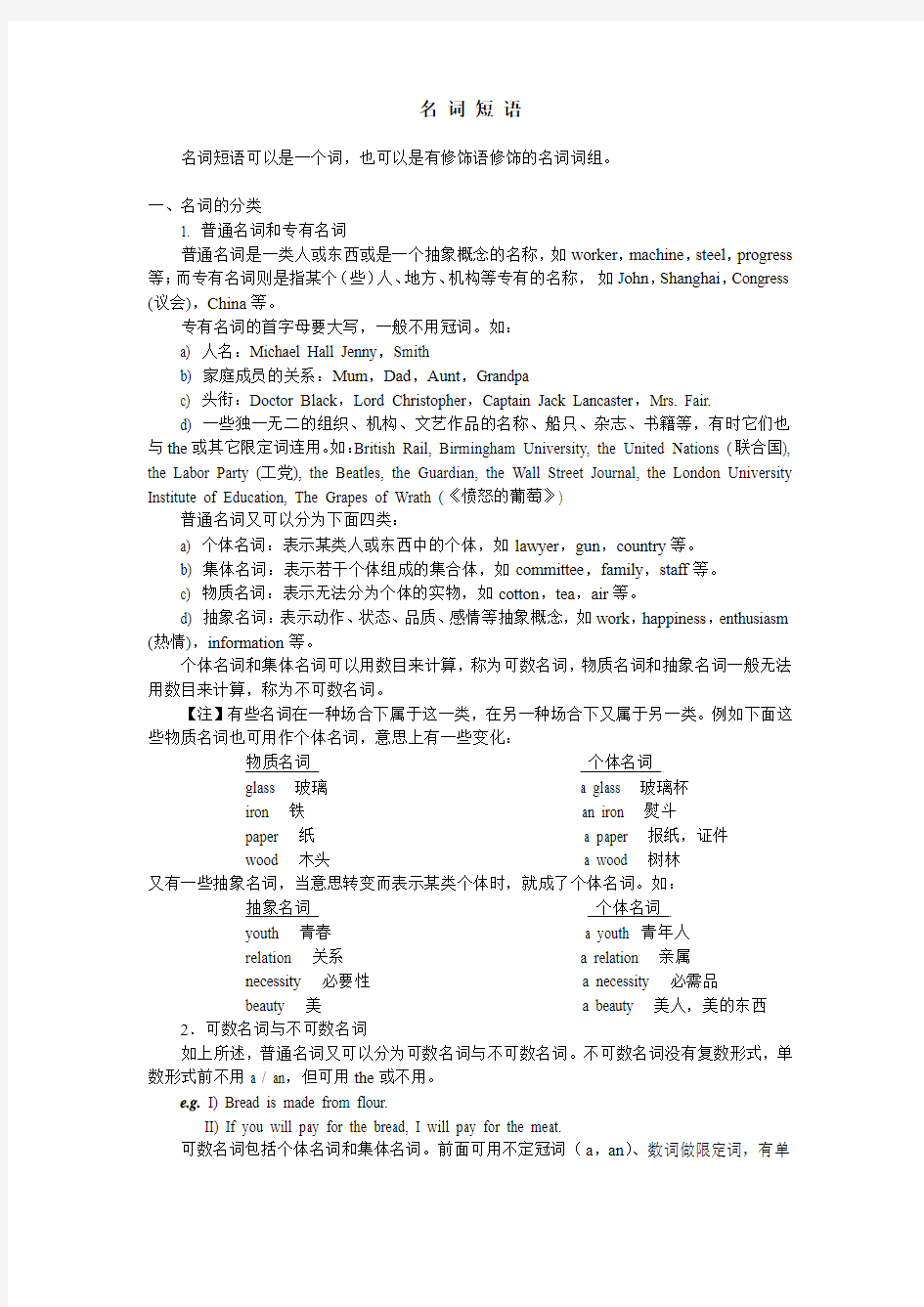1.1 名词短语


名词短语
名词短语可以是一个词,也可以是有修饰语修饰的名词词组。
一、名词的分类
1. 普通名词和专有名词
普通名词是一类人或东西或是一个抽象概念的名称,如worker,machine,steel,progress 等;而专有名词则是指某个(些)人、地方、机构等专有的名称,如John,Shanghai,Congress (议会),China等。
专有名词的首字母要大写,一般不用冠词。如:
a) 人名:Michael Hall Jenny,Smith
b) 家庭成员的关系:Mum,Dad,Aunt,Grandpa
c) 头衔:Doctor Black,Lord Christopher,Captain Jack Lancaster,Mrs. Fair.
d) 一些独一无二的组织、机构、文艺作品的名称、船只、杂志、书籍等,有时它们也与the或其它限定词连用。如:British Rail, Birmingham University, the United Nations (联合国), the Labor Party (工党), the Beatles, the Guardian, the Wall Street Journal, the London University Institute of Education, The Grapes of Wrath (《愤怒的葡萄》)
普通名词又可以分为下面四类:
a) 个体名词:表示某类人或东西中的个体,如lawyer,gun,country等。
b) 集体名词:表示若干个体组成的集合体,如committee,family,staff等。
c) 物质名词:表示无法分为个体的实物,如cotton,tea,air等。
d) 抽象名词:表示动作、状态、品质、感情等抽象概念,如work,happiness,enthusiasm (热情),information等。
个体名词和集体名词可以用数目来计算,称为可数名词,物质名词和抽象名词一般无法用数目来计算,称为不可数名词。
【注】有些名词在一种场合下属于这一类,在另一种场合下又属于另一类。例如下面这些物质名词也可用作个体名词,意思上有一些变化:
物质名词个体名词
glass 玻璃 a glass 玻璃杯
iron 铁an iron 熨斗
paper 纸 a paper 报纸,证件
wood 木头 a wood 树林
又有一些抽象名词,当意思转变而表示某类个体时,就成了个体名词。如:
抽象名词个体名词
youth 青春 a youth 青年人
relation 关系 a relation 亲属
necessity 必要性 a necessity 必需品
beauty 美 a beauty 美人,美的东西2.可数名词与不可数名词
如上所述,普通名词又可以分为可数名词与不可数名词。不可数名词没有复数形式,单数形式前不用a / an,但可用the或不用。
e.g. I) Bread is made from flour.
II) If you will pay for the bread, I will pay for the meat.
可数名词包括个体名词和集体名词。前面可用不定冠词(a,an)、数词做限定词,有单
数形式和复数形式。
e.g. I) A dog is an animal.
II) There are many dogs in the village.
可数名词的复数形式通常有以下几种情况:
a) 大多数名词是在单数名词后加-s,如:girl → girls,book → books, cat → cats。
b) 以s,x,ch,sh 结尾的名词在词尾加-es,如:class → classes, box → boxes, brush →
brushes, match →matches。如词尾ch的发音/k/,其复数要加-s。如:stomach (胃)→
stomachs, epoch (纪元,新时代) → epochs。
c) 以o结尾的单词有些加-es,如:hero → heroes,potato → potatoes,tomato → tomatoes
等;但也有一些以o结尾的名词变复数时在词尾多加-s,尤其是外来词或缩写词,如:piano → pianos;其它的还有:photo,tobacco (烟草),memo (备忘),solo (独奏)等。同时,一些词末以两个元音字母结尾的词变复数时也是加-s,如:radio → radios,bamboo → bamboos,studio (演播室,摄影棚)→ studios,zoo → zoos,cuckoo (布谷鸟)→ cuckoos,kangaroo (袋鼠) → kangaroos等。另外,cargo (货物),motto (座右铭),volcano (火山) 等加-s 或-es 均可。如:cargo → cargos / cargoes, mosquito (蚊子)→mosquitos / mosquitoes。
d) 以辅音加y结尾的名词变y为i再加-es。如:family → families,lady → ladies。但y
前面是元音字母时只加-s。如:day → days, key → keys,boy → boys,donkey (驴)→donkeys,guy (家伙)→ guys。
e) 以f 或fe 结尾的名词大多加-s构成复数。如:chief (首领)→chiefs,cliff (悬崖)→
cliffs,roof (屋顶)→ roofs等。但有些以f 或fe 结尾的名词要去掉f 或fe在词尾加-ves。如:calf (小牛)→ calves, half → halves。其它的还有:knife, leaf, life, loaf (一块
面包), self, shelf (架子), thief, wife, wolf等。另外,hoof (蹄), scarf (围巾),wharf,staff (旗杆,柄),dwarf (侏儒),handkerchief (手帕)等加-s 或去掉f 或fe 后加-ves均可。
如:hoof → hoofs/ hooves, handkerchief → handkerchiefs/ handkerchieves。
f) 年代和缩写词的复数通常加s构成,但有时也可加’s。如:the 1990 → the 1990s / 1990’s,
VIP → VIPs / VIP’s。
g) 复合名词的复数的构成有以下几种形式:
i) 将主要名词变为复数,如:editor-in-chief (主编)→ editors-in-chief, looker-on (旁观
者)→ lookers-on。
ii) 由man, woman加名词构成的复合名词的复数,需将man, woman及其所修饰的
名词同时变为复数。如:man nurse → men nurses, woman doctor → women doctors。
iii) 没有名词的复合名词,通常把s加在最后一个词上。如:grown-up (成年人)→grown-ups, breakdown (崩溃)→ breakdowns。
h)有少数名词有不规则的复数形式,通常有以下几种情况:
i) 有一些名词保存了英语中古旧的复数形式,如:child → children,man → men,
woman → women,tooth → teeth,foot → feet,goose (鹅)→ geese,mouse → mice,
ox (公牛)→ oxen等。
ii) 有一些是外来词,仍保有原来的复数形式,如:phenomenon (现象)→ phenomena,
formula (公式,方程式)→ formulae,thesis (论文)→ theses,basis (基础)→ bases,
analysis (分析)→ analyses,criterion (标准)→ criteria,crisis (危机)→ crises等。
iii) 有一些名词单复数形式相同,如:Chinese →Chinese,Japanese →Japanese,
aircraft (航行器)→ aircraft,sheep → sheep,deer → deer,means (方法)→ means,
series (系列)→ series,species (物种)→ species等。
【注1】有些名词经常以复数形式出现,这些名词中有的表示由两部分构成的东西,如服装穿戴类的名词:trousers,glasses,jeans (牛仔裤),shorts (短裤),pajamas (睡衣),spectacles (眼镜)等和工具器皿名词:scissors (剪刀),compasses (圆规)等。这类名词如泛指可以不用限定词,如指明是一件衣服或工具可在名词前加some 或 a pair of,一件以上则用“数词+ pairs of”修饰。如:some scissors,a pair of new gloves (手套),three pairs of jeans。
【注2】集体名词的单数形式做主语时,如果将其看作整体,动词用单数形式,若看作该整体中的若干个体,动词用复数。
e.g. I) The team is playing well this year. 今年该队打得很好。
II) The team are scattered all over Europe during their holidays. 该队队员在假期中分散到欧洲各地。
【注3】可数名词与不可数名词并没有严格的界限,有些名词根据其不同的词义或用法既可以用作可数又可以用作不可数名词。
e.g. I) Do you care for tea? 你爱喝茶吗?
II) Long Jing is a well-known tea. 龙井是一种名茶。
III) We were again in great difficulty. 我们有一次陷入了困境。
IV) They carried on the work in spite of the difficulties. 尽管有种种困难,他们还是把工作进行下去了。
二、名词的格
1. 所有格的构成
英语名词的格有两种表现形式:’s属格和of- 属格。一般情况下,大多数名词所有格由名词加-s构成。一般说来,分为以下几种情况:
a) 单数名词通常加-’s,如:my brother’s book;Linda’s pen;以-s结尾的单数名词可以
加-’s或者只加’,如:Mr. Jones’ house;a waitress’s job;
b) 以-s结尾的复数名词则只在单词结尾加’,如:the teachers’ office;the workers’ time;
而以非-s结尾的复数名词则直接在单词后加-s,如:the policemen’s opinions (观点);
the women’s hobbies (爱好);
c) and连接的两个人名的’s 跟在后一个词后面,如:Hart and Risl ey’s study;
d) 复合名词及各类称号的所有格,’s 跟在最后一个词后面。如:the Secretary of St ate’s
visit,April Fools’ Day;
e) 首字母缩写词的所有格为单数时其后用-’s,复数时用’,如:a n MP’s salary (议员的
薪水);Mps’ salaries。
【注1】在下列情况,一般用of-结构表示所有格而不用-’s。
i) 没有现成复合名词可表示的物体,如:the book of the film,the shade of a tree (树荫);
ii) 某样物体的一部分,如:the bottom / top / side / inside of the box;
iii) 抽象概念:the cost of living,the price of success。
2. 所有格的意义
a) 表示有生命的名词,如women’s clothes,the horse’s tail等。
b) 用于国家机关、社团及一些地理名称,如the government’s property (政府的财产),
The European Economic Community’s exports (欧共体的出口)等。
c) 用于船只、飞机、火车等中表示整体与部分的关系,如:the ship’s bell,the train’s heating
system等。
d) 用于表示时间、距离、价值和表示重量的名词,如:a moment’s thought,eight hours’
drive,two dollar s’ worth,a ton’s weight等。
e) 常用于一些习惯用语中,如for heaven’s sake (看在老天爷的份上),at his wit’s end (不
知所措)等。
【注1】-’s结构有时可以和of-结构构成双重所有格,但名词前不用the来修饰,而用a,any,some,these,those等限定词来修饰。如:
e.g. I) They saw a play of Shakespeare’s.
II) Some friends of my brother’s will come to join us.
当双重所有格用this,that,these和those修饰of短语前面的名词时,往往可以表示爱憎褒贬等情感。如:
e.g. I) That little girl of your cousin’s is really a dear.
你表哥的那个小女儿真逗人爱。(比Your cousin’s little girl更有赞美的意味。)
II) How can you put up with that irritating habit of Peter’s?
你怎么受得了彼得那个令人讨厌的习惯?(比Peter’s irritating habit带有更强的厌恶情绪。)
【注2】某些名词的所有格加上定冠词the表示一种场所,如:the g rocer’s (杂货店),the hairdresser’s (理发店),the dentist’s (牙科诊所),the baker’s (面包店)等。
